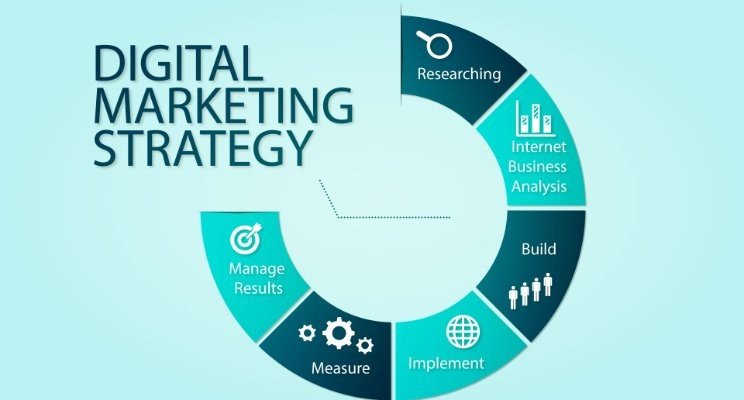Any firm in the modern digital era needs to have a well-defined and practical digital marketing strategy. Developing a strategy from the ground up can be intimidating, regardless of whether you’re starting a new business or reevaluating your existing plan. However, you may put up a strong plan that will increase traffic, lead generation, and conversions with the correct measures. This is the way to get going.
1. Define Your Goals
Every effective approach begins with well-defined goals. With your digital marketing initiatives, what goals do you want to accomplish? The SMART criteria (Specific, Measurable, Achievable, Relevant, and Time-bound) should guide your goal-setting.
- Examples of Goals:
- Increase website traffic by 30% in 6 months.
- Generate 200 qualified leads in the next quarter.
- Boost eCommerce sales by 15% within 90 days.
Defining goals gives direction to your strategy and ensures you’re working toward measurable results.
2. Understand Your Target Audience
A successful marketing plan depends on identifying your target audience. By knowing your target audience’s demographics, hobbies, and online habits, you can define them. Make thorough buyer personas to direct your advertising endeavors.
- Questions to Answer:
- Who are your ideal customers? (Age, gender, location, job titles, etc.)
- What challenges or pain points are they facing?
- Where do they spend time online (social media platforms, forums, blogs)?
Use analytics, surveys, and social media insights to refine your personas further.
3. Conduct a Competitive Analysis
Your competitors can provide valuable insights. Analyze their digital presence and look for gaps you can fill.
- What to Look For:
- What channels are they using (social media, email, SEO, PPC)?
- How are they engaging with their audience?
- What keywords are they targeting?
- What content types are they producing?
Tools like SEMrush, Ahrefs, or BuzzSumo can help you gain an understanding of competitors’ strategies.
4. Choose Your Digital Channels
A successful digital marketing strategy leverages multiple channels. However, you don’t need to be everywhere at once. Choose channels that make the most sense for your business and audience.
- Examples of Channels:
- Social Media: Platforms like Facebook, Instagram, LinkedIn, and TikTok for brand engagement.
- Search Engine Optimization (SEO): Improving organic search visibility on Google.
- Content Marketing: Blogs, videos, eBooks, and infographics to provide value.
- Pay-Per-Click Advertising (PPC): Targeted ads on Google, Facebook, or Instagram.
- Email Marketing: Direct communication with your audience to nurture leads and drive conversions.
Each channel serves a different purpose, and your selection should align with your goals and audience behavior.
5. Create a Content Strategy
Content is the backbone of digital marketing. Create a content strategy that speaks to your audience’s needs and drives them toward your objectives.
- Key Considerations:
- Types of Content: Blog posts, how-to guides, videos, podcasts, webinars, etc.
- Content Distribution: Decide how often and on what platforms you’ll publish.
- SEO Optimization: Ensure content is optimized for search engines by incorporating relevant keywords.
- User Intent: Understand what your audience is searching for and create content that meets their needs.
Consistency and quality are key to keeping your audience engaged and building trust.
6. Set Your Budget
Digital marketing can vary greatly in cost depending on the channels you use. It’s essential to allocate your budget effectively across different tactics.
- Budget Allocation:
- Paid advertising (PPC) on Google or social media platforms.
- Tools for SEO, email marketing, or social media management.
- Content creation costs (blog writers, video production, graphic design).
- Software subscriptions for analytics or marketing automation.
Make sure your budget aligns with your goals and focuses on high-ROI activities.
7. Measure and Adjust Your Strategy
Once your digital marketing strategy is in place, it’s important to track performance and make adjustments as needed.
- Key Metrics to Track:
- Website traffic (overall and from specific channels)
- Conversion rates (how many visitors turn into leads or customers)
- Social media engagement (likes, shares, comments)
- Email open and click-through rates
- ROI on paid ads
Regularly review analytics data to determine what’s working and where you need to tweak your approach.
8. Test and Optimize
Digital marketing is not a one-size-fits-all solution. It’s a constantly evolving process that requires continuous testing and optimization. Experiment with different ad creatives, content formats, or posting schedules to see what resonates best with your audience.
A/B testing can be particularly useful in optimizing your campaigns. For instance, test different subject lines in your email marketing to see which drives higher open rates, or experiment with various landing page designs to improve conversions.
Building a digital marketing strategy from scratch may seem overwhelming, but by following these steps, you’ll create a well-rounded, data-driven approach that can lead to business growth. Start small, stay flexible, and refine your strategy as you gather more insights. With the right plan in place, you’ll be on your way to achieving your marketing goals.
